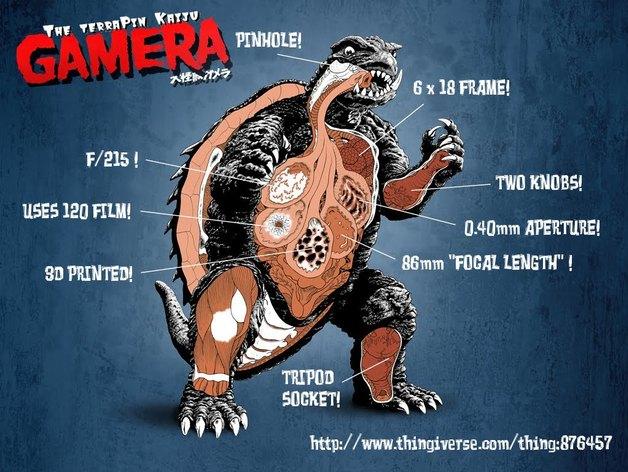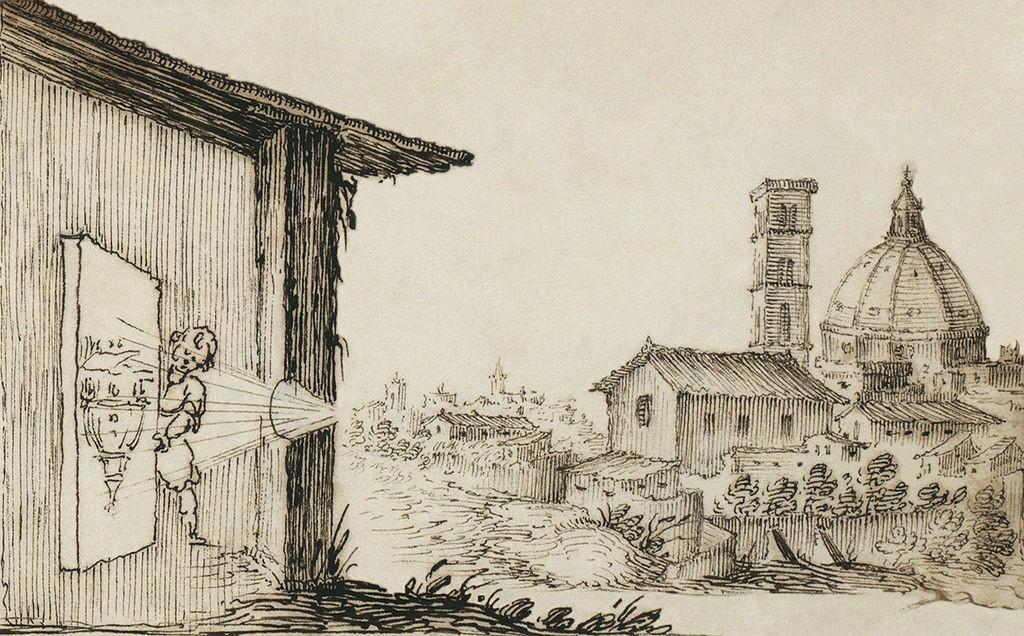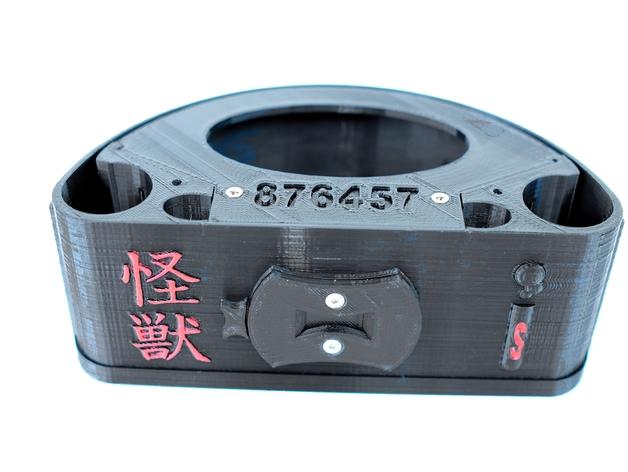 Maker and self-professed “polygeek” Todd Schlemmer combined his love of Japanese monster films, cameras and photography, 3D design and printing, and open sharing to create what he calls his “terraPin Kaiju 6×18 Pinhole Gamera,” for which Schlemmer has shared instructions and .stl files on Thingiverse.
Maker and self-professed “polygeek” Todd Schlemmer combined his love of Japanese monster films, cameras and photography, 3D design and printing, and open sharing to create what he calls his “terraPin Kaiju 6×18 Pinhole Gamera,” for which Schlemmer has shared instructions and .stl files on Thingiverse.

Camera Obscure, from a manuscript of military designs, Illustration of camera obscura from “Sketchbook on military art, including geometry, fortifications, artillery, mechanics, and pyrotechnics,” possibly Italian, c. Library of Congress.
“Kaiju” is a Japanese word that means “monster.” It refers to a genre of tokusatsu, or special effects entertainment. Kaiju films typically feature monsters of all kinds and the monsters are most often laying siege to a major Japanese city. Or, they’re fighting other monsters. Think Godzilla and Megalon, for example. Schlemmer grew up watching Kaiju movies and his favorite monster was Gamera, a rocket-powered flying turtle beast. And that’s the inspiration for the camera. In his words:
“The terraPin Kaiju is a giant, mutant pinhole Gamera!”
What’s a pinhole camera, though? It’s the most basic kind of camera there is. It is a variation on the camera obscura (in Latin that’s “dark chamber”), the earliest camera–but smaller and super minimalist. It’s an optical device that consists of a box (larger ones can even be entire rooms) with a hole in one side of it. Light from a scene outside of the box passes through the hole and strikes an interior surface. There it is reproduced upside down but with the color and perspective of the scene preserved. The image can be projected on light-sensitive paper or can be traced by hand onto a piece of paper. Exposure time can range from about five seconds to several hours. The best photos are of static scenes.
Schlemmer’s Pinhole Gamera uses 120 film, which is good for still photos. He shared several examples of photos he’s taken with it and they are surprisingly good–although none (so far!) capture the kind of creatures for whom the camera is named.
 As for the appearance of the Gamera itself, it’s probably obvious that the embellishment on the exterior is purely decorative, albeit pretty cool.
As for the appearance of the Gamera itself, it’s probably obvious that the embellishment on the exterior is purely decorative, albeit pretty cool.
Some finishing of the 3D printed parts is required to ensure that the pieces fit together properly as, it probably goes without saying, even the smallest amount of light that gets in from somewhere other than the pinhole is unwelcome.
Once you’ve made your own Pinhole Gamera, you’ll want to refer back to the Thing page for Schlemmer’s instructions for using the device, including loading the film onto the spools and winding it. He’s more than happy to respond to questions as well via the comments section so that others can benefit from the Q&A as well.
According to Schlemmer, it’s his “mission to share and promote open source cameras and related parts created with CAD applications and 3D printing.” We love the way that this camera, the Pinhole Gamera, combines the latest technology–3D design and printing–with the long-standing technology of the first, rudimentary camera. Let us know what you think of this fun take on photography in the 3D Printed Gamera forum thread over at 3DPB.com.
Subscribe to Our Email Newsletter
Stay up-to-date on all the latest news from the 3D printing industry and receive information and offers from third party vendors.
You May Also Like
3D Printing Unpeeled: Biofuel Waste to Filament & Sustainable Photopolymers
I can’t ever remember a day with so many potentially high impact news stories have come out. In one story, we all know that there are problems with the safety...
Finnair Hires AM Craft to 3D Print Plastic Parts for Aircraft Interiors
Riga-based AM Craft, a supplier specialized in 3D printing aviation components and certified under EASA Part 21G, announced a significant achievement today. The company will assist in upgrading Finnair’s A320...
3DPOD Episode 198: High Speed Sintering with Neil Hopkinson, VP of AM at Stratasys
Neil Hopkinson, a pioneering 3D printing researcher, played a pivotal role in developing a body of research that is widely utilized today. He also invented High Speed Sintering (HSS), also...
3D Printing Webinar and Event Roundup: May 12, 2024
Webinars and events are picking up in the AM industry this week! ASTM International continues its Professional Certificate Course and Stratasys continues its advanced in-person trainings, while 3D Systems is...
































